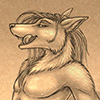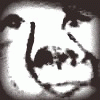
As much at the mercy of the cruel sea as their prey, the crews of the stalking u-boats were hunters prowling the trackless wastes of the North Atlantic. In the First War they had hunted singlely, achieving modest success. But in this war, a new tactic of banding several u-boats together into efficient killer-groups was being tried against the supply convoys. And it was proving appallingly successful.
This picture was brilliantly suggested to me by an unknown artist’s work at AnthroCon 2000 (?). I wish I could have bought the picture then because I really like his or her play on the word “wolfpack” as it applied to the Battle of the Atlantic.
My own work here achieved the story idea that I had in my head. If I were to do this pic again I would have implemented a few changes but nothing decidedly different from what you see here.
This picture was brilliantly suggested to me by an unknown artist’s work at AnthroCon 2000 (?). I wish I could have bought the picture then because I really like his or her play on the word “wolfpack” as it applied to the Battle of the Atlantic.
My own work here achieved the story idea that I had in my head. If I were to do this pic again I would have implemented a few changes but nothing decidedly different from what you see here.
Category All / General Furry Art
Species Wolf
Size 600 x 600px
File Size 51.3 kB
I too find the usage of real wolves at villains to be false. They are no more villains than lions or tigers or any of the world's other predators.
BUT, having said that, in the make-believe world of anthropomorphic art, I believe that wolves, anthrowolves, make great villains. They are handsome, intelligent and are closely associated with group predatory efforts.
As for Der Fueher reinforcing any negative stereotypes about wolves, what about the eagle? The Romans topped the standards of their conquering legions with the eagle and oppressed peoples for nearly a thousand years. Napoleon in his empire’s rise and fall used the eagle in his symbology. And for those events of the United States past and present that might be judged negative it too has represented itself by the use of an eagle.
Surely, the wolf comes up as a poor second-rate villain by comparison with the eagle through human history at what has been done in its image.
BUT, having said that, in the make-believe world of anthropomorphic art, I believe that wolves, anthrowolves, make great villains. They are handsome, intelligent and are closely associated with group predatory efforts.
As for Der Fueher reinforcing any negative stereotypes about wolves, what about the eagle? The Romans topped the standards of their conquering legions with the eagle and oppressed peoples for nearly a thousand years. Napoleon in his empire’s rise and fall used the eagle in his symbology. And for those events of the United States past and present that might be judged negative it too has represented itself by the use of an eagle.
Surely, the wolf comes up as a poor second-rate villain by comparison with the eagle through human history at what has been done in its image.
Having an affinity towards wolves, I am somewhat prejudiced in my view that while wolves can make good villains having them EXCLUSIVELY as villains is a bad idea.
The eagle is very rarely shown as a villain, though. In fact it is quite often shown as a noble bird despite the associations you have mentioned. And of all the empires that have risen or fallen Hitler's still remains in the human mind as the most evil for its actions.
The eagle is very rarely shown as a villain, though. In fact it is quite often shown as a noble bird despite the associations you have mentioned. And of all the empires that have risen or fallen Hitler's still remains in the human mind as the most evil for its actions.
Yes, WWI, but not entirely civilian. She was carrying large amounts of munitions to England, the explosion of which sent her to the bottom. The Germans placed ads in the NY newspapers warning that the ship carried a military cargo and would be sunk. Only one torpedo was fired, there were two explosions, the second much larger than the first. Her cargo manifests were finally declassified a couple of decades ago.
*laughs* Thank you, Kharnak. That's a very astute observation regarding the condensation. All the surfaces should have been shown as being wetter since fog does coat everything with condensation when you are driving through it. Just think that the Herr Kapitan has a very efficient crew that constantly goes around the outside of the boat with wipe cloths blotting up that condensation. :D
Thats fantastic, really caught the atmosphere in that one, even though such U boat formations were rare, but I think next time a bit more fatigue, I mean U boat crews got really tired and uniformes did become a bit tatty, plus sea and battle damage on the actuall U boat too, other than that is a good picture ^^
In October of 1940, convoy SC7 lost 17 out of 34 ships just west of Ireland to a wolfpack of just 7 u-boats operating on the surface. Far greater losses to larger packs would happen in the months ahead.
As for the captain's appearance, well just summise that he has taken up station in the wolfpack on just coming out from home. But for now, the u-boat crews would call it the "Happy Times".
As for the captain's appearance, well just summise that he has taken up station in the wolfpack on just coming out from home. But for now, the u-boat crews would call it the "Happy Times".
A monitored part of living on a small cramped ship is cleanliness. An outbreak of a communicable disease on boat can be as deadly to the ship as a depth charge. In this the captain has to set the standard by example.
Yes, I choose to illustrate this u-boat kapitan as just coming on station with a new boat in 1942 so that he and his ship are clean and ready for action. If I pick up this thread again I will cast it around 1944 when the wear & tear of continual combat in a losing war will be a strong element in how I show it.
Yes, I choose to illustrate this u-boat kapitan as just coming on station with a new boat in 1942 so that he and his ship are clean and ready for action. If I pick up this thread again I will cast it around 1944 when the wear & tear of continual combat in a losing war will be a strong element in how I show it.
Yes, 1942 was the turning point in the war. The decisive battles of Midway, Stalingrad, and El Alamein all occurred between June and November of that year. Those Axis defeats clearly stated that the Axis would not win the war -- though it did not say that they would lose it. That was still to be decided.
As Churchill very aptly described it later, "Ah, this is not the end. It is not even the beginning of the end. But it is perhaps the end of the beginning.” In the following year the imperiled world would see the tide of war finally begin to flow against the Aggressor Nations. And the leaders and peoples of those nations would no longer be fighting to win the war, but to avoid destruction.
As Churchill very aptly described it later, "Ah, this is not the end. It is not even the beginning of the end. But it is perhaps the end of the beginning.” In the following year the imperiled world would see the tide of war finally begin to flow against the Aggressor Nations. And the leaders and peoples of those nations would no longer be fighting to win the war, but to avoid destruction.
I am genuinely troubled by today's abysmal lack of historical knowledge. In a recent poll taken in Great Britain, 23% of British teens thought that Winston Churchill was just a myth.
I can see the centuries between now and the times of Richard the Lionhearted rendering him as a figure of myth and legend (he wasn't by the way) in the popular mind. But when the reality of the single-most important person to stand against the unimaginable tyranny of the Second World War when all the odds were against him and the nation he led is in question -- then that is an indictment against the Educational System of the first magnitude.
I will continue to do my part to keep the memory of the Past alive so that this generation and future ones may be stirred to at least be familure with what happened and why it happened so that they can recognize it when it comes again.
Ha, Ha, Lionus the Crusader Lion!
I can see the centuries between now and the times of Richard the Lionhearted rendering him as a figure of myth and legend (he wasn't by the way) in the popular mind. But when the reality of the single-most important person to stand against the unimaginable tyranny of the Second World War when all the odds were against him and the nation he led is in question -- then that is an indictment against the Educational System of the first magnitude.
I will continue to do my part to keep the memory of the Past alive so that this generation and future ones may be stirred to at least be familure with what happened and why it happened so that they can recognize it when it comes again.
Ha, Ha, Lionus the Crusader Lion!
*nods* What we were, most certainly shapes what we can or will be now and in the future. Without some knowledge of History, no people in the parlance of the young can "find themselves" or know who they can be. They become the malleable fodder for the next “visionary” to use in shaping an "iron dream".
Thank you, Stevenc.
Whenever I can I try to research the uniforms and weapons of the period I am portraying in my artworks.
The uniforms of the U-boat crews changed quite a bit in the first two to three years of the war. Initially the German Navy was not ready for war. Its long-held plans were to be ready three years later for a war that in the main would be fought very much like WWI. There would be one or two really big naval battles slugged out by battleships, probably in and around the North Sea, with U-boats employed in sweeping up the shallow coastal waters of stray warships or the occasional merchantman.
But incredible success on land gave the Navy bases along the entire length of the French Atlantic coast, an excellent position from which to attack the trans-Atlantic trade of the resisting island nation. Uniforms initially designed for the short coastal U-boat missions were only slowly replaced.
The kapitain I have depicted here is wearing one of the newer uniforms circa 1942 as befitted the captain of a new longer ranged U-boats setting out on patrol in the North Atlantic.
Whenever I can I try to research the uniforms and weapons of the period I am portraying in my artworks.
The uniforms of the U-boat crews changed quite a bit in the first two to three years of the war. Initially the German Navy was not ready for war. Its long-held plans were to be ready three years later for a war that in the main would be fought very much like WWI. There would be one or two really big naval battles slugged out by battleships, probably in and around the North Sea, with U-boats employed in sweeping up the shallow coastal waters of stray warships or the occasional merchantman.
But incredible success on land gave the Navy bases along the entire length of the French Atlantic coast, an excellent position from which to attack the trans-Atlantic trade of the resisting island nation. Uniforms initially designed for the short coastal U-boat missions were only slowly replaced.
The kapitain I have depicted here is wearing one of the newer uniforms circa 1942 as befitted the captain of a new longer ranged U-boats setting out on patrol in the North Atlantic.
It is always a pleasure for me to share what inspired me to do any of my various artworks, whether it was just an idea from a movie, or some piece of actual history. And the best part, when it was from History, is that I will never give a surprise quiz at the end of the week to grade you on what you remember.
In the harbour of Bremerhaven (quite a 3 minutes walk away from my flat) there is the Wilhelm Bauer - one of the many "Wunderwaffen" of the third Reich. That submarine never saw a fight however.
I can kinda imagine Kehno being the commander of that submarine, yelling : "Okay guy. now to the right." *hitting a giant rock*
"Ah dammit. left LEFT! I meant left!"
I can kinda imagine Kehno being the commander of that submarine, yelling : "Okay guy. now to the right." *hitting a giant rock*
"Ah dammit. left LEFT! I meant left!"
*laughs* And exactly who was it that promoted Kehno to submarine commander when the lion can not tell his right from his left? :-D
And speaking of submarines, just last week a diver off the coast of Massachusetts (the state along the east coast of the US where I live) claims to have discovered the wreck of a British freighter that was sunk by a U-boat. Nothing special in that. Doenitz's boys were having a good time in 1942.
Acording to the diver, however, the wreck holds a cargo of platinum that is worth on today's market, three billion dollars.
And speaking of submarines, just last week a diver off the coast of Massachusetts (the state along the east coast of the US where I live) claims to have discovered the wreck of a British freighter that was sunk by a U-boat. Nothing special in that. Doenitz's boys were having a good time in 1942.
Acording to the diver, however, the wreck holds a cargo of platinum that is worth on today's market, three billion dollars.

 FA+
FA+





























Comments